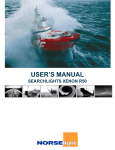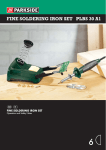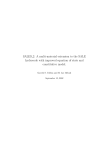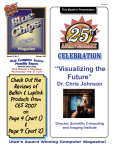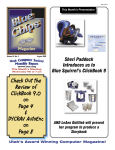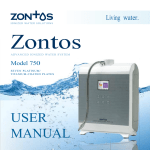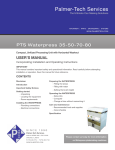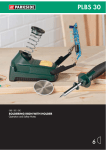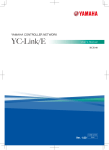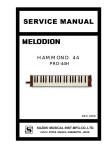Download LARRY Precaution
Transcript
Safety Precaution ※Read and study these Safety Precaution for correct handling and operation. IMPORTANT for YOUR SAFETY! PLEASE READ AND STUDY CAREFULLY CONTENTS MARK & WARNING..............................................................1 ~ 6 1. Check the Packing List......................................................6 2. Safty Label........................................................................6 3. Parts of the Wheelckair....................................................7 4. Before Using.....................................................................8 5. Adjustment.......................................................................8 6. Sheet belt. (Option)..........................................................8 7. Maintenance....................................................................9 MECHANICAL Maintenance CLEANING Maintenance AIR PRESSURE Maintenance.........................................10 8. Recomedation on the Strage location............................10 9. Fundamental Method of Riding......................................10 10. Manufacturing Serial Number.................................. ....11 11. WARRANTY....................................................................11 <LARRY> Safety Precaution ※Read and study these Safety Precaution for correct handling and operation. IMPORTANT for YOUR SAFETY! PLEASE READ AND STUDY CAREFULLY CAUTION Issues which may cause serious accidents or damages as a consequence of mishandling WARNING Issues which may cause fatal accident as a consequence of mishandling PROHIBITED MANDATORY ACTION “MUST NOT DO” to prevent any potential serious injury or fatal accident “MUST DO” to prevent any potential serious injury or fatal accident CAUTION Issues which may cause fatal accident as consequence by mishandling ● ▷ ● ▷ PROHIBITED PROHIBITED of any unauthorized modification and disassembling of the product. NEVER modify and disassemble of the product without the authorization of manufacturer since such action will degrade the durability and the robustness NEVER put your foot (or feet) onto the footrest(s) getting into or getting out of he wheelchair. When getting into or getting out of the wheelchair NEVER attempt to stand on the footrest(s) as such action is dangerous and may cause the wheelchair to fall over. ● DO NOT place the wheelchair near a fire It is extremely dangerous to place the wheelchair near a fire: as the sheet may catch fire, some plastic part may deform and Also can cause of burning injury coming in contact with the heated metal parrt. ● ▷ AVOID unbalanced weight distribution Never vigorously sit or jump onto the wheelchair, this may cause unbalance of the wheelchair. ● ALWAYS SIT on the SHEET ONLY ● Care person or other persons are prohibited from sitting on the wheelchair other than on the sheet provided ● Never ride with more than one person in the wheelchair. ▷ ▷ ▷ ▷ ▷ ▷ The wheelchair is for one person to ride. The wheelchair may suffer damage or cause an accident if more than one person is riding. 1 ● NEVER lean on the end grip ● NEVER use as walking frame ● Never adjust any part on the wheelchair other than the part which allows the user to adjust as per the instruction sheet. Consult with the reseller for the adjustment. ● ● Never force the wheelchair to go over large bumps or ramps. The care person MUST STOP before going over any ramp. The care person should use the tipping lever or the rear part of the wheel to go over the ramp. ▷ BEFORE GOING over the ramp, reduce your speed. Failure to comply may be the cause of the wheelchair suffering damage on the frame or caster wheel. ● Never start or go over the ramp on a angle - the caster wheels should always be aligned with the direction of the ramp It is too dangerous to force the wheelchair to go over the ramp without straighten the caster wheel. This may be the cause of the caster wheels to be damaged. ▷ ● A Rider MUST align the wheelchair wheels at right angles to cross a rail line or enter or departing from a lift. It is dangerous due to potential of the wheel falling into the gap between the rail and road or the elevator compartment and entrance section. Also, it is highly recommended to cross with the care person. ▷ A rider MUST never ride against the flow of traffic – a rider should always ride on the footpath. The rider should follow the pedestrian rule requirements in each country. ● Never lean out of the wheelchair while the wheelchair is in motion. It is extremely dangerous and may cause the wheelchair to become unbalanced and uncontrollable. ● Never lean too far forward with a bent posture ▷ Never attempt to pick up any object in front of the wheelchair by adopting a forward-bent posture. This may cause the wheelchair to become un-balanced and topple over which is extremely dangerous. ● Never use the wheelchair other than the for the original wheelchair design purpose. NEVER use the wheelchair as a Carrier, or as a stool. Standing on the wheelchair is extremely dangerous. YOU MUST hold tightly onto the frame after setting the brake when lifting the wheelchair Do not lift the wheelchair by the back support; this action is dangerous since it may cause detachment of the push handle. It is highly recommended that to lift the chair when a rider is present that 3 persons are required to ensure the balance is maintained for the rider, always fasten the sheeting belt and never lift by any part of the body parts of the user. 2 CAUTION Issues which may cause fatal accident as consequence by mishandling ● MUST be assisted by care person when climbing over the hilly place. Push wheelchair forward to climb up a hill. Slowly go downhill with the wheelchair backward. Note: It is dangerous to go down the hill with the wheelchair facing forward as there is potential to slip off the seat or fall forward and be out of control. It is also dangerous just in case the care person lose their balance while supporting the wheelchair. ● It is important that the rider gives full attention when transversing a slope. ● The Brake MUST be applied when getting on or off the wheelchair, or when resting in the wheelchair. ● The rider MUST place both feet on the foot rest while riding the wheelchair. It is potentially dangerous to ride with your feet not positioned on the footrest. There is a potential risk for one or both feet to be caught between footrest and ground. Extreme care is needed in the case when the riding person is moving the wheelchair by his or her own foot. Mandatory Action ● The care person MUST study and understand the function and operation of the wheelchair before provides assistance or care. ● Faulty or damaged components should always be replaced to prevent further damage or an accident. ● Avoid riding when the following condition are evident:Heavy traffic, gravel road, bumpy road, muddy section of the road, snowy road, icy road, cliff, river bank, gutter without fence, shoulder part of the road, on the seawall, during the night, when it’ s raining, during heavy fog, or strong wind. ● A care person should be present if its mandatory to ride in any of the above conditions. It is strongly recommended the care person provides assistance by holding the body of the rider in the wheelchair when riding it the following circumstances:Narrow road, railroad crossing, pedestrian crossing, platform of railway station, entering or leaving an elevator, walking aisle with wheelchair feature, wheelchair compliance automobile, or any other potential dangerous location. The rider should fasten the sheet belt when the wheelchair is equipped with a sheet belt. Wheel(s) etc may catch the unfastened sheet belt. 3 PROHIBITED ● A rider MUST confirm that the sheet pipe is securely set in the sheet slot before starting to ride. ● If the sheet pipe is not set properly in the sheet slot, there is potential for the frame to distortion or brake. Subsequently it may be the cause of an accident. ● NEVER throw, drop, or cause excess shock to the wheelchair ● NEVER drive the tyre directly. ● NEVER drive the wheelchair with one hand as this has the potential to un-balance the wheelchair. Always drive with both hands to keep a balanced situation. ● NEVER force the brake lever in a direction other than the direction of operation. NEVER apply excess force more than is required to move as this may cause deformation or brakeage of the brake mechanism. ● NEVER leave the wheelchair for long periods of time at the following location:Nearby traffic, near by a ramp and bumpy road, outdoor nearby sea (where exposed at salty air), in-front of an emergency exit, fire extinguisher or hydrant, Under direct sunlight (including the inside of motor vehicles), close to combustion heating equipment (eg. nearby stove), the reaching hands of children. ● NEVER ride the wheelchair with low air pressure in the tyre or with any damaged or broken parts. This may cause a malfunction or brakeage or an accident. The correct air pressure is 5Kg/cm3. Pressure higher than this may cause damage / puncture of the tyre tube. ● The rider MUST always check the wheelchair before riding. The wheelchair is a mechanical device and some deterioration / wearing of parts may occur over time during use. ● The Rider MUST take precaution to prevent their fingers being caught in the rotating wheel / tyre. 4 CAUTION Issues which may cause fatal accident as consequence by mishandling ● A rider should check for burrs on the frame of the wheelchair. Impact, corrosion etc. may cause of burr. Such burrs may be the cause of injury. ● ASSISTANCE from the care person must be sought in the case of the person with cognitive impairment when riding the wheelchair. This is to ensure the wheel chair is operated safely and correctly. There is some risk of swallow some components of the wheelchair or the sheet. Also, there is risk of release the brake accidentally. PROHIBITED ● The rider MUST operate brake bar by hand. It may cause the brake damage if operated by the foot. ● The care person MUST confirm the safety of the sheeting for sitting on before the user before start to ride. The care person and or the rider should always avoid the tyre, spoke, caster wheels, and pedestrian to ensure that the wheelchair does not catch any part of any garments from their own body / the rider / or from people in close proximity to the wheelchair during operation. ● It is strongly recommended assistance is provided by care person by holding the body of the user of the wheelchair during the following circumstances Steep slopes, bumpy road/location, gaps such as railroad crossing or elevators, or any other potential danger location. ● Care person should not provide assistance by sitting on the wheelchair ● The rider MUST be careful to put their feet onto the step when riding barefoot to avoid injury. Riding barefoot has the potential to increase the risk of injury contacting with a wall or column. It can be cause of broken bones. ● Two care persons are recommended when transferring the rider when the wheelchair is on unstable ground. ● MUST NOT EXCEED MAXIMUM ALLOWABLE CARRYING WEIGHT (the maximum weight includes any object carried by the user) 5 CAUTION Issues which may cause fatal accident as consequence by mishandling Travelling by Air Plane It is strongly recommended to inform the airline company or the ticket seller about needing wheelchair access prior to the travelling. Lack of communication has the potential to cause delays at check-in or boarding - In some cases you may be prevented from travelling. 1. Check the Packing List The following items are included in this package. Precaution Manual 1 set Warranty Sheet 1 pc Tools (Spanner, hex wrench) 2 pcs 2. Safty Label Important safety instruction/precaution label is attached. Only use the product after reading and studies the safety label. Avoid getting dirty Never peel off the label ● ● ● ● Left Side of the plate CAUTION It may be possible to fall off and get injured ● ● ● ● ● ● ● ● ● A care person must read and study the instruction sheet carefully the Rider or Care person MUST flip up the footrest and set brake firmly. Never lean too far forward to pick up some dropped object Not raise/float front wheel too much to ride over obstacles. Never exceed the maximum weight allowance. Confirm the armrest is fixed. Confirm the footrest is fixed. Confirm if there is any looseness or damage to the front wheels (caster). Sit only on the sheeting Right Side of the plate CAUTION It may be possible to fall off and get injured ● ● ● ● Never lift objects when the wheelchair is mobile. Assistance of care person is required for the cognitive impairment to keep and confirm the safety. The rider /care person must confirm if the sheeting is set properly to the sheeting slot. The rider /care person must avoid hands or garments being caught in the mechanism. 6 3. Parts of the Wheelchair 1 2 3 4 5 6 7 8 9 End Grip Combined Unit of the armrest and the side guard Footrest set 3-a Height Adjustment system for the footrest 3-b Footrest 3-c Heel guard Caster Brake Wheel 6-a Hand rim Tipping Lever Backrest Sheet 7 4. Before Using ・Please check all parts of wheelchair are operational before riding the wheelchair. <Check the attachment for security and correct fitment> ● back sheet and the sheet ● armrest ● cloth ● heel guard ● footrest <Checks for the tyre > ● Enough air (Optimum pressure is 5kg) ● No loose valve ● Any damage on the tyre - Anything stick in the tyre ● Any shallow tread of the tyre <Check the brake> ● Working Properly? ● Rear Wheel locked when the brake is applied. <Check the armrest> ● Firmly attached? ● No scar or no crack? <Check the footrest> ● Firmly attached ● Joint hook not detached ● No loose nuts or bolts <Check on overall wheelchair > ● No loose parts ● Able to run straight Long term use has the potential to wear part, caster wheel, leg part, armrest etc. Make sure these are checked before the user rides. Do not use the wheelchair if there is any abnormal part detected. 5. Adjustment. Please check WEBSITE URL: http://www.move-inc.jp/indexe.html next crick “Maintenance” button. 6. Sheet belt. (Option) Sit correctly on the sheet of the wheelchair, then fasten sheet belt. Maximum attention should be given to prevent falling over. It is easy to be unbalanced the wheelchair when get on or off from the wheelchair. It is effective to use anti-fall over metal fitting (optional). Hold the rear part of the wheelchair by someone assisting. …. Also you may help preventing the wheelchair from falling over by resting the wheelchair against a bed or wall. Caution ● Always fasten sheet belt for the model equipped with Sheet belt while riding to prevent falling off f rom the sheet. ● Remove any dust or lint on the surface of fastener, or replace sheet belt. The adhesion will be weaken and may cause of accident. * In case the adhesion of the fastener of the sheet belt is weaker, then the sheet belt must be replaced. 8 7. Maintenance MECHANICAL MAINTENANCE When tighten or loosing screws with tools such as wrench or screwdriver, it is recommended to wear gloves. In the case where an abnormality is observed, stop riding the wheelchair immediately. ● Are all wheels contacting on the ground? Confirm the two front caster wheels and the two rear wheels are correctly contacting the ground surface. IF any of four wheels are not contacting to the ground, it may be caused by loose screws or distorted frame, immediately contact with the sales entity. ● Can wheelchair fold properly? If the wheelchair cannot be folded properly, it may be caused by loose screw or insufficient lubrication, by grease, contact with sales entity. ● Check all wheels are firmly attached? Are there any loose bolt holding the wheels – if yes then immediately contact the sales entity. All bolts are tightened correctly when the wheelchair is shipped from the factory. However it is possible that they may loosen caused by the vibration of riding. It is highly recommended to periodically check the tightness of the nuts and bolts. CLEANING MAINTENANCE ● Carbon Frame and Side guard and wheel, Always use a neutral detergent commercially available and dilute with warm water. ● Metal Parts (wire spoke wheel etc.) Normally it is not necessary to use any water or liquid to clean up mild dirt. Just remove using a dry cloth. However if any convex/concaved part or heavily attached dirt is present then again use a neutral detergent commercially available and dilute with warm water. ● Sheet Use warm water and then wipe with clean cold water to finish and then dry. In case of heavy dirt, Remove such dirt with the cloth soaked with a neutral detergent and then wipe off using a cloth soaked with clean water to clean up. NOTE :<Heavy Dirt> When dirt is difficult to remove use a neutral detergent commercially available and dilute with warm water then wipe the part by the cloth soaked with water. A sponge or brush can assist with the removal of some stains. In this case wash the part by hand using warm water. Never use machine washing or dryer. Warning Never wash with hot water or ozone gas. It may cause a break down, deterioration, discolorations etc. ● ● Do not use detergents other than neutral detergent or any volatile liquid (organic solvent) such as toluene, benzene, etc. Washing by non-neutral detergent or organic solvents may cause deterioration or discoloration or damage to the material. ● Never use scrubbing brush, hard brush or polishing powder (including cleanser). It may damage the material. 9 AIR PRESSURE MAINTENANCE. Correct Air pressure for tyre? Always ensure the air pressure is correct for wheelchairs fitted with air tube tyre. ● It is natural for air tyres to loose pressure over time. The appropriate air pressure is indicated at the side wall of the tyre. ● Under pressured tyres may also be much heavier to move the drive wheel. Incorrect pressure may make the tyre prone to insensitive braking or puncture. Without the use of a tyre gauge, generally speaking, the approximate air pressure may be determined by depressing the tyre – it should feel hard (similar to the hard rubber ball). Example of proper air pressure (pressure measured using a air pressure gauge) ● ● ● ● 18 to 24 inch wheel: 400kPa Light weight 22 inch: Generally 700kPa 22inch :700kPa 16inch : 300kPa NOTE: The tube used in this wheelchair is English Type and not the U.S. type. This means that the valve structure only allows air to be added in one direction. It is not suitable to reduce the air. Therefore, standard pressure gauge cannot be applied to measure the pressure. Therefore, the air pump with air pressure gauge must be used to adjust proper air pressure. Then, adjust the aforementioned reference pressure using such pressure gauge at the air pump. Can detect enough depth of the tread at the tyre? Worn tyre, which has shallow tread, will cause slipping and/or a puncture. It may also cause insensitive braking. Also, it is important to check for cracks in the rubber of the tyre of the caster wheel. ● 8. Recomendation on the Storage location. Store the wheelchair at safe place after maintenance. ●Never leave wheelchair or component(s) at the following location. On the Street At the bumpy Location Near the Sea (where the wheelchair may be exposed to sea breeze which contains corrosive salt contents) In front of an Emergency exit, Fire extinguisher, or fire hydrant ・Nearby a stove when the fire is alight ・Keep out of the reach of children ・Slope ・Outdoors in extremely warm or extremely cold weather ・in a crowded place with people ・In a high humidity place or in the rain or wind or exposed to direct sunlight (which including the inside of automobile) ・Dusty places ● ● ● ● 9. Fundamental Method of Riding Wheelchairs are normally categorized as a pedestrian by law. Therefore, you should follow the laws applicable to pedestrian. Wheelchairs are normally permitted to ride in the place which has traffic plates of “Pedestrian and bicycle only ” or “pedestrian only” – However you must follow the laws in your country For pedestrian traffic signal, do not attempt to cross the road once the blue/red light has started blinking and wait for the next timing of green light to start. Always give yourself enough time to cross a road safely. Transferring User This is a method to assist the user to the bed from the wheelchair. It must be safe and comfortable for both care person and the user. The care person places one hand between knees of the user and holds the back of the user by other hand to assist the user to stand up. Move the back of the care person toward wheelchair while holding the knee part of the user. Then, slowly let the user sit on the bed. It is good practice to give a count each other “one” “two” “three” for each motion. 10 GO OUTSIDE For your own safety, “slowly” and “fasten sheet belt” are two fundamental important issues. SLOPE For uphill slopes, the user should bend their posture forward to protect from “push back” and the care person will push and move step by step. For downhill slope, lightly apply the brakes and the care person and wheelchair should move backward down the slope step by step. In all cases ensure the sheet belt is securely fastened. To go down the ramp, Move backward to move down using the rear wheel first, and then simultaneously step on the tipping lever to move front wheel slowly down. ================================================= OVER GUTTERS *Always check and confirm the size of the gutter and it is safe to cross. 1 As mentioned before ” raising caster wheel” for ramp, step on the tipping lever and step on the tipping lever to raise the caster wheel from the ground. *Give a sign with your voice to the user when about to proceed with this motion. 2 Move forward while the caster wheel is raised, then slowly land the caster wheel when the caster wheel has crossed the gutter. 3 Then lift the rear wheel and move forward and then land slowly when it crosses over the gutter. 10. Manufacturing serial number. It is important to always get the wheelchair serviced. Also, record the model and manufacturing date. MODEL MANUFACTURING DATE 11. WARRANTY Warranty will be given only when the wheelchair has been used in accordance with the user manual. In such a case, repair works will be carried out free of charge. ★Warranty card. This product is shipped with warranty card. Fill out the warranty card and return it to manufacturer by post within one month after the purchasing to register. Warranty will not be extended if the warranty card is not completed and returned. . ★Warranty period One (1) year after the purchased date (consumable parts is not included) ★After warranty period Consult with the sales entity. Repairs will be completed but at a cost to the user/owner. Consumable component list Front wheel (wheel only) Back sheet Footrest set Bearings Sheeting Armrests Tyres Tyre tubes Heel guard Rear wheel (wheel only) (Valve rubber) 11 ★Warranty will not be extended to 1. The natural wear of consumable components or damage caused by poor daily maintenance / handling. Examples: puncture of the tyre, damaged/brakeage of wire, sheet, steps etc. 2. Any damage caused by the natural disaster such as earthquake, typhoon, flood accident, fire, and act of gods. 3. Any damage caused by mishandling by untrained handlers or the careless handling or for any damage as a result of repairs completed by an unauthorized repair entity. 4. Any damage caused by applying non genuine/authorized component. 5. Damage caused by any usage at the location where wheelchair cannot be used or any unusual condition. 6. any damage caused by usage of the wheelchair for non-wheelchair usage. 7. Any damage caused by not following this user manual. 8. any damage caused by handling or action which is prohibited by this user manual. ● The warranty period of component supply. 5 years after obsolete of function components. Function component is any component, which is mandatory to realize the function of the product. ● Request of the repair work Stop using the wheelchair and contact with sales entity when any abnormal condition is observed. ● In case the wheelchair is passed to / sold / or given to other persons other than the original user. The new person must receive the USER MANUAL. ● Once the product is used it cannot be exchanged or credited. ● The users should follow the rules of the authority (including local government authority) to dispose this product to protect the natural environment. DISTRIBUTOR PRODUCER MOVE INC. YOKOHAMA CITY NAKAKU 3-15-2 JAPAN 12














